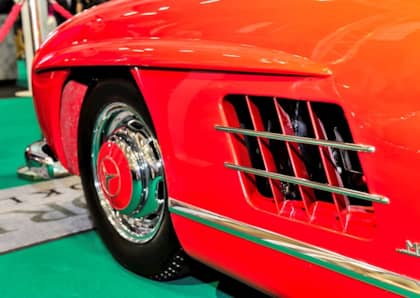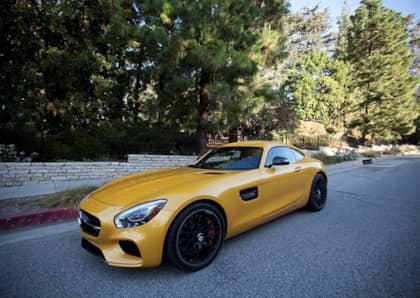722 Express
Sixty years ago Mercedes-Benz had a motorsport season that no other organization has experienced, before or since, triumph and tragedy on an epic scale. Triumph in Formula One with five wins out of six and a World Championship. Tragedy at Le Mans when the Mercedes-Benz 300 SLR of Pierre Levegh flew into the crowd killing himself and 83 spectators, injuring many more.
Six decades have passed since that summer, those who were lost are still rightly commemorated and in the run up to this year's Le Mans 24 Hours there was a moving memorial ceremony. At this year's Techno Classica, Mercedes-Benz recalled 1955 by paying tribute to those who suffered and also celebrating the brighter side of that year.

One performance stood out even in that season of great achievement. On May 1st, 1955, Stirling (these days Sir Stirling) Moss and his co-driver Denis Jenkinson won the Mille Miglia in a Mercedes-Benz 300 SLR.

The Mille Miglia was the mad race in Italy using public highways, on a journey from Brescia to Rome and back again. In 1955 the course was 922-miles long and #722 completed the race in 10 hours, 7 minutes and 48 seconds, at an average speed of 98.5mph. 98.5 MILES PER HOUR! This on rather primitive 1950's Italian roads and in front of an estimated five million spectators, about 10% of the Italian population of the time.

Numbered 722 in reference to the car's starting time 07:22am, the racers were started at one minute intervals with the slower cars being waved off the night before. Moss and Jenkinson finished 32 minutes ahead of their teammate, Juan Manuel Fangio, in another 300 SLR.

Their drive has passed into motorsport legend for many reasons, perhaps one of the most famous was the use of pace notes between Jenkinson and Moss. This form of navigation was not new but Jenkinson had taken the level of detail contained within his notes to an accuracy not seen before.
The pair had completed a series of reconnoitres in the months leading up to the race, sometimes at racing speeds. Jenkinson condensed his notes onto a single roll of paper, 17 feet long. Moss had a special aluminium case made with two rollers allowing Jenkinson to read the notes containing the knowledge painstakingly accumulated. They devised a series of hand signals that would enable them to communicate.

It took a great level of trust as they were putting their life into the other's hands - in the 50's a mistake in motorsport was frequently fatal. Mercedes-Benz had tried out a radio communication system but Moss tuned the sound out as he approached the limit of performance, concentrating solely on the car and the road... at least he could see the hand signals.
While he always played down his role in the victory, Jenkinson was vital to Moss' speed giving only one wrong signal in the ten hours, this despite being car sick from the exhaust fumes and being lurched around the cockpit (no racing harnesses back then). "Jenks" was a tough character, having won the Motorcycle Sidecar World Championship in 1949 as the passenger.

Not content with winning the Mille Miglia, Jenkinson sat in his hotel room for the following two days writing his report and column for Motor Sport of the event. He then wrote a 10,000 word personal account of his time sitting next to Moss. It stands the test of time as an example of great writing and a fantastic chronicle of one of the great motorsport performances ever. "Jenks" himself passed into motorsport legend as one of its most incisive scribes.

The tragedy at Le Mans prompted the management of Daimler-Benz to consider the competition future of the company. In September Moss, with John Fitch, won the RAC Tourist Trophy at Dundrod. The following month he took victory in the Targa Florio this time with Peter Collins, capturing the 1955 FIA World Sportscar Championship for Mercedes-Benz. It would be the final race for the 300 SLR as the board at Daimler-Benz decided to end all motorsport activity with immediate effect.
The era of racing on public highways was also about to end; the cars were getting faster and faster, capable of 180mph, a disaster waiting to happen. A few weeks later Levegh's accident in France accelerated that feeling, many considered banning motor racing altogether. The final act of the Mille Miglia happened in 1958 when the Ferrari of De Portago and Nelson flew into the crowd at Giudizzolo di Mantova, killing themselves and nine spectators, five of them children. The Italian government banned road racing and Enzo Ferrari faced charges that the Englebert tires fitted to the factory entries were not suitable for the conditions and that, as head of the team, he was aware of these deficiencies. It would be nearly five years before the charges were dropped.
(Archival photography: Courtesy of and copyright Daimler AG, Mercedes-benz Classic; all other images by the author)











